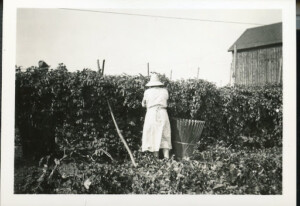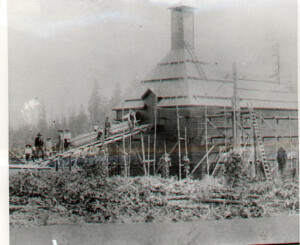Hops and Beer
Sam Adolph founded the first Salem brewery with John Brown at Church and Trade Streets in Salem in 1862. When Adolph’s brewery burned in 1869, it was relocated to the southwest corner of Cottage and Trade streets. In 1885 Adolph joined with two of his employees, Maurice Klinger and Seraphin Beck, to build the Capital Brewery on the northeast corner of Commercial and Trade Streets, which produced mainly draught beer but also had a small bottling plant behind the brewery.
The Salem Brewery Association bought the business in 1903 and produced Salem Beer. With their new buildings and modern equipment the business became one of the most modern on the west coast. When Salem voted to go dry in 1913, the Association moved to Portland and it wasn’t until prohibition was repealed that the Association re-incorporated. In 1943 Sick’s Brewery bought the Salem plant and ran it until the building was razed in 1955. The brewery had a party room on the second floor where various civic and private groups met and a large sign on top advertising “6 Sick’s Select Beer.”

1920 c., Back view of woman in large hat picking hops with a large basket next to her., WHC Collections 1997.014.0080
Another early brewery was founded by Louis Westacott in 1866. His Star Brewery, located at the foot of Mission Street, used horse power to operate the pumps, malt mill and other machinery. He felt that the $30,000 Oregon spent annually to import hops could be saved if the hops, grown locally, could be cured more carefully. Since the market price was in proportion to the strength of the beer, he felt that the local growers, through their ignorance of hop culture, were not preserving their crop in optimum condition.
Westacott’s Star Brewery kept its lager below ground in a very cool cellar and his product was judged to be of superior taste. Lager beer was in vogue at the time and was frequently prescribed (in moderation) by physicians as a relief from the heat. The brewery was torn down in 1909 to make way for the John Minto home. Workmen at the site found an old beer bottle which still smelled of the beer from twenty years earlier.
In 1870 Salem had thirteen bars and thirteen drugstores dispensing liquor; the population was 1139 people. Two years later there were three more breweries operating – the Pacific, City, and Pioneer breweries.
During the years when the breweries existed, the Willamette Valley was dotted with hop yards and dryers. Hop cultivation is a year-around proposition involving preparation of the poles and trellises; construction and maintenance of the wooden dryers; and pruning, propagating and planting at the beginning of the season. During the summer there is irrigating, fertilizing and training of the shoots to be done. In the fall it is time for harvesting, drying and baling for shipment to market.

1890 c., Hop Dryer, Posed with large bathtub like container of Picked Hops, being moved up a ramp to the Drying Level. Men and children posed on ramp. Salem Public Library MJON 0094, WHC Collections 1998.012.0057
The increase in hop cultivation made for an influx of many migrant workers into the areas surrounding Salem. Nearby Independence even proclaimed itself the “Hop Center of the World” and held a festival and parade. In 1896 there were ten hop growers in Salem alone with many others up and down the Valley, and by 1902 the American Hop & Barley Company of London had an office in Salem. The buildings in the 100 and 200 blocks of Commercial Street housed many hop agencies, as did the Bush-Breyman Building and the Hirschberg Building at the Northeast corner of Commercial and State.
The Ladd and Bush Quarterly for July 1912 proclaimed “The best hop is grown in our river bottoms … A choice Oregon hop is incomparable. It stands in a class of its own and always commands a premium in all the markets of the world”. Although there were no breweries listed in the Salem City Directory during the years of prohibition, Salem still had 23 growers and dealers. The T. A. Livesley Company had extensive holdings in South Salem and, instead of selling locally they shipped to England, providing 1/30th of the international hop market.
In the 1940s, mechanization, changing tastes and changing marketing practices worked against local growers. Hop growing began to decline in the valley. Today you must travel to rural Marion County to see hop fields like the ones that used to be close to Salem.
Researched and written by Joan Marie “Toni” Meyering
Bibliography:
Salzmann, Joan Marie “Toni”. “Hop Agriculture in the Willamette Valley.”
Marion County History, School Days II, Vol. 14 (1983-84), p 28-47.
Salem Daily Record, June 28, 1867.
This article originally appeared on the original Salem Online History site and has not been updated since 2006.







Leave A Comment